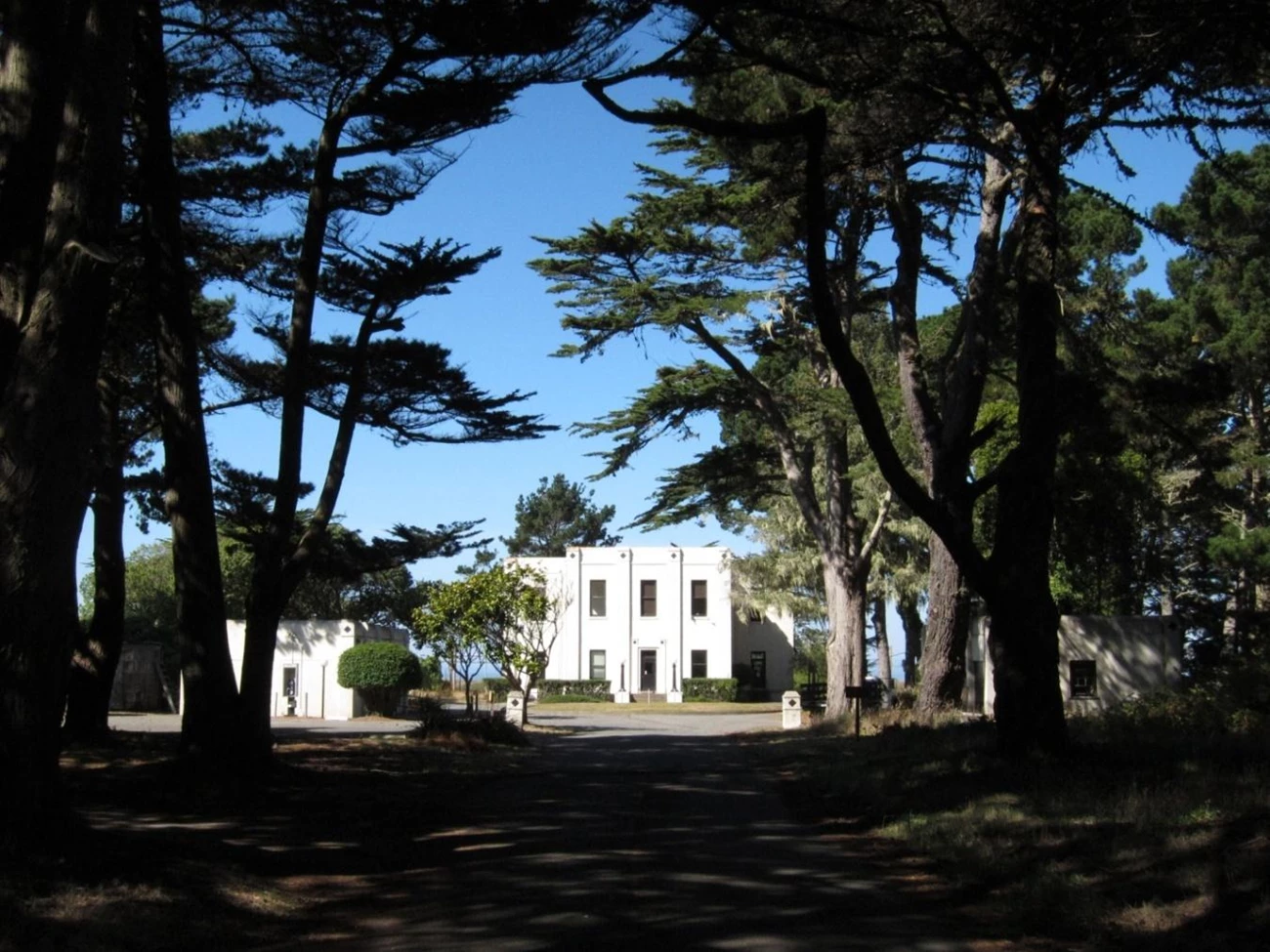Last updated: September 22, 2023
Article
Monterey Cypress Allée at RCA Point Reyes Receiving Station

(NPS/PWRO)

(NPS/Point Reyes National Seashore Museum, Collection #PORE 9755)
The Agricultural Landscape of Point Reyes Peninsula and the Communications Industry
As part of the cultural landscape at RCA Point Reyes Receiving Station, the allée reflects the convergence of agricultural and industrial land use on the peninsula. In 1913, the British-owned Marconi Wireless Telegraph Company of America began purchasing grazing lands on the southern tip of the Point Reyes peninsula. The proximity to the coast, open character of the landscape, and relative lack of atmospheric interference to radio signals provided an ideal place to invest in the expansion of wireless communication operations in America.After WWI, support for the Americanization of wireless communications in the United States was strong. The Marconi Company was dissolved and sold its American holdings to the newly created Radio Corporation of America (RCA). With advancements in short-wave radio technology of the 1920s, RCA added a new receiving station on the northern end of Point Reyes peninsula by taking the 1,472-acre ranch of James McClure (G-Ranch) through condemnation, which RCA leased back later to various ranchers for continued grazing.
In 1929, RCA constructed a receiving station far enough away—20 miles—from its sister transmission facility at Bolinas to avoid any signal interference. Similar to the RCA buildings at the Bolinas transmission station, the receiving station exhibited the Art Deco style in its buildings and a formal, symmetrical arrangement of designed landscape features near the RCA Receiving Building. Extending from the designed landscape, RCA installed a quarter mile long, tree-lined gravel road.

(NPS/Point Reyes National Seashore Museum, Collection #PORE 9755)
Unlike the designed plantings surrounding the circular drive at the RCA Receiving Building, the cypress allée at the receiving station was installed without a formal plan. Designers of the receiving station may have been influenced by the agricultural windbreaks they saw on the Point Reyes peninsula and combined this element with the aesthetic qualities of a double row allée to complement the Art Deco complex.

(Oregon State University)
A Narrow Range Broadens
The Monterey cypress (Cupressus macrocarpa) is endemic to two small forest locations on the central coast of California where it thrives in windy, humid conditions, one at Cypress Point in Pebble Beach and the other at Point Lobos near Carmel. Its contorted form is a response to the windswept coastal environment. Though not native to the Point Reyes peninsula, the cypress allée at the RCA Receiving Station has adapted well. When planted circa 1930, each row of trees in the allée was offset about 15 feet from the road’s edge and spaced approximately 40 feet apart, numbering over 60 trees in all. By the 1980s the allée matured into its current iconic “tunnel” form, with the upper limbs meeting over the roadway.
Today, the historic mature cypress allée supports a number of bird species including raptors and owls. Like the Monterey cypress on the Point Reyes peninsula, which can now be found dotting the landscape as ornamental plantings and windbreaks, this species has been widely cultivated throughout the world and become naturalized in places as far away as New Zealand.

(Pacific Aerial Surveys, #AV1013-03-12)
NPS Stewardship
In 1978 the NPS acquired the outlying fields at the receiving station with the 23-acre core complex remaining in commercial use. In 1999, the NPS purchased the remaining core area for inclusion in PRNS. In 2018, the allée was listed on the National Register of Historic Places as a contributing resource of the RCA Point Reyes Receiving Station Historic District and is considered in fair condition, though in decline. Since 2010, the NPS performed preservation maintenance work to remove hazardous, damaged, and dead material from the allée’s canopy. A few weakened trees were also removed.
Because the allée’s historical significance depends on the integrity of the whole, the recommended treatment for preservation is to replace the entire two rows with new plantings when the trees no longer retain integrity as an allée. Until then, NPS resource managers plan to extend the life of the allée and retain its historic character by cleaning the canopy and removing volunteer saplings.
One notable threat to the health of the resource includes visitor impacts. Recently, social media has contributed to the popularity of the allée and attracted additional visitation. Parked vehicles and increased foot traffic within the critical root zone have the potential to contribute to soil compaction and reduced plant health. As a solution, NPS has closed the road of the cypress tree allée to vehicular traffic to eliminate this risk and allow for an improved visitor experience.

(NPS)
Today’s visitors continue to enjoy the iconic allée as they journey to the Point Reyes Lighthouse Visitor Center or stop at one of the last remaining Morse code radio stations along the Pacific Coast. Though many of the antennas that once dominated the use of this area have been removed, the allée remains as a vestige of the peninsula's combined agricultural and industrial heritage.
Discover More
Learn about the Marconi/RCA Bolinas Transmitting Station and RCA Point Reyes Receiving Station Historic District at Point Reyes National Seashore
